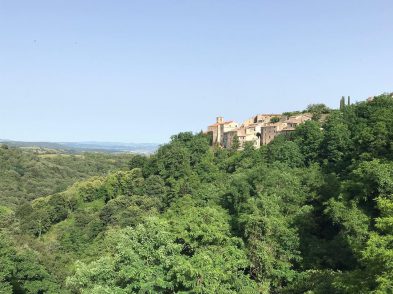Every Christmas village needs a Santa, even in a small southern Tuscan town where not so long ago that job was filled by another senior citizen.
In the years before I ever imagined moving to Italy, my mother would tell me stories of the Befana. It was 1960s Calabria, but it could have easily been ripped from a scene in De Sica’s Bicycle Thieves.
My mother would fall asleep on January 5 clutching her knock-off Barbie from four birthdays ago. In the morning, she would wake with a small bundle of gifts on her bed, sweets mostly, but also a pair of leather sandals with a polished silver buckle. Every year, it was the same. The Befana would bring her the pair of shoes she instinctively knew would have to last the entire year. She wasn’t expecting a visit from Babbo Natale. She didn’t even know he existed.
Five decades later and 688 kilometres north, I find myself in my own Italian village as it scrambles to out-Christmas its southern Tuscan neighbours. It’s no mean feat. Pitigliano is shelling out thousands on a temporary ice rink, in part to attract tourists, in part to stick it to the Mancianesi who are their perpetual rivals.
This year, Manciano will not be left in second place. From December 8, the town will be transformed into a Winter Wonderland with all the trappings of the American heartland: fake snow, a mini railway, a state-of-the-art light show projected directly onto the 12th century fortress and a tiny Lemax village complete with ski resort and fun fair.
And at the centre of it all is one elderly figure, a character of bedtime stories and children’s letters—Saint Nick or, as the locals call him, Babbo Natale.
The old adage “don’t send a man to do a woman’s job” has played out in reverse and across Italy: children growing up in towns like mine recognise the Befana as nothing more than an excuse to get another round of presents just as the shine of the ones they received on December 25 is starting to wear off.
But this is not a story of lost traditions and forgotten folklore. Instead it’s the tale of the man behind the big red suit.
I’ve been fascinated by him for the better part of 2016, even though I only met him once. During last year’s festivities, I dutifully stopped by Santa’s house. Crammed full of antiques, it was a gorgeous sight, entirely designed and decorated by local volunteers. Santa looked a little out of place. Perhaps because he wasn’t used to such luxury. Or perhaps because he’d just lost his pants.
I can only imagine most Western first graders would have screamed at the sight of an old man with his trousers around his ankles. Their Tuscan counterparts, however, were unfazed. As for me, almost 365 days have passed and I can’t say I’ve really gotten over being flashed by Santa.
This marks the second year Ernesto Filippi will play the role of Babbo Natale. He’s a quiet man, which is a polite way of saying he’s a grump and like my mother, he grew up with the Befana.
In these parts, he tells me, men and women would dress up as the old witch and her husband. They would knock on doors and dance the Ballo della Befana, a lively folk tune with plenty of twists and turns, accompanied by a few strong voices and one accordion. At the song’s end, the youngest would hold out a basket and the homeowners would show their appreciation with a piece of cheese or a bottle of wine. When the last home had been visited and the last song sung, the carollers would share their bounty in a celebration that lasted until dawn.
Unsettled, I ask Ernesto how it feels to be playing a character that was utterly foreign to him as a child.
“The world moves. Times change. The Befana never really brought us anything but chocolates and socks. Santa Claus brings toys. If you were a child, who would you rather believe in?”
It’s brash and pessimistic, but that’s Ernesto’s way. Half the town wasn’t sure they wanted to rehire him, concerned not about Pants-gate but about his surly attitude and reluctance to hug the children.
Now semi-retired, Ernesto has worked six-day weeks since his was 14. He starts each morning at 6am and finishes at dusk. His children are part of the generation that would have done anything to see the back of Manciano and he has no grandchildren.
He was picked to play Santa because he is round and robust and has a white beard, but more importantly, he was the only one who volunteered. It’s not something you’d expect from a man who otherwise keeps to himself, tending his small vegetable patch and playing cards at the local communist-affiliated community centre.
“Every Christmas village needs a Santa. It makes the kids smile. Simple.”
But what about the Befana? I ask. Doesn’t she deserve a place on Italy’s festive stage?
“For many of us, the Befana is a beautiful memory of our childhood, but she also represents hard times. Gifts were scarce and they were always things we needed. Kids these days are spoilt, it’s true. Santa will bring them whatever they want, but they have fewer worries and that’s a good thing.”
Let’s just hope that, this year, Santa remembered the rope for his oversized velvet pants.
Meet Ernesto
Manciano’s Villaggio di Natale is on from December 8 to 18.
For more information, visit the website.








